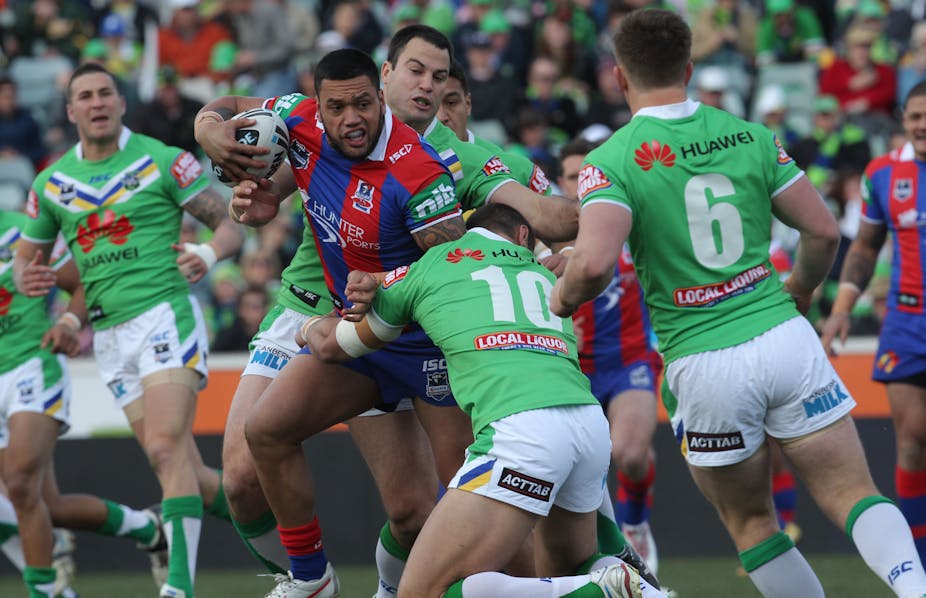The Australian Rugby League (ARL) Commission’s decision last week to ban the shoulder charge from all competitions from 2013 has divided fans. Some applaud the decision in the name of improving player safety; others have ridiculed the ban and want to continue to be entertained by spectacular bone-jarring collisions.
Even some players and coaches, who have the biggest stake in player safety and career longevity, claimed they were “shocked” and “bemused” by the ban.
What does it mean?
The change to Section 11, Law 2 of the Rules (Tackle and Play the Ball) states that:
a defender who runs at a ball carrier and without attempting to tackle, grab or hold the ball-carrier using arms or hand, charges to make direct physical contact with the shoulder or with the upper arm (tucked into the side) is guilty of misconduct (dangerous collision).
The rule change was based on a review by the ARL Commission which showed that while the shoulder charge only accounted for 0.05% of tackles in the season, 17% resulted in contact with the head of the opponent, 5% resulted in injury, and the injury ratio (injury per incident) was higher than conventional tackles.
As players have been shown to be getting bigger and faster, and because the shoulder charge generates greater G-force than conventional head-on tackles, there is concern that the force generated in collisions will increase the likelihood of injury.
The rule change won’t eliminate forceful body contact in rugby league. But it will encourage tackles rather than “big-hit” collisions. Players will have to position themselves differently to execute a tackle, presumably spreading the surface and reducing the force of impact and the likelihood of injury.
There is some debate about the data underpinning the rule change, but there seems to have been enough evidence to convince the ARL Commission.
The Commission’s decision may have also been informed by a growing body of research on the effects of acute and repeated head injuries in sport on brain function – some indicating long-term brain damage, depression, and dementia. In fact, more than 2,000 American athletes recently filed a suit against the National Football League, claiming the league withheld information about the extent and health impacts of brain injury suffered by its players.

The shoulder-charge ban is in line with rule changes in other football codes to protect athletes from concussion and other serious head injuries. The shoulder charge is already banned from rugby union. And in the NRL, “dangerous throws” – where the tackled player’s head is the first part of the body to make contact with the ground – can carry a suspension for up to nine weeks. This is similar Australian Rules football’s “sling tackle”.
In American (gridiron) football, “head-down” tackling and spearing have been banned; and the kick-off has been moved from the 30 to the 35 yard line, thus decreasing kick-off returns and the number of potentially injurious high-velocity collisions between players.
The business of sport
Gone are the days in sport when high-risk on-field actions could be defended on the grounds they were simply “part of the game”. Sport is well and truly a business, and managers have a legal duty of care for employees and are expected to be proactive in preventing injury in the workplace.
Lurking behind the player safety issue is not only a concern to avoid potentially costly litigation by injured players, but also to maintain grass-roots participation, which could be jeopardised if parents perceive contact sports such as rugby league are too dangerous for their children.
Workplace safety is a significant concern for employers and governments, as well as employees and their families. In Victoria, for instance, WorkSafe ads have been appearing on television for a decade to raise awareness of and improve workplace safety.
Yet, these workplace safety messages can fall on deaf ears in sport. Contact sports such as rugby league and union, as well as Australian and North American (gridiron) football, are often thought of as a type of (hyper)-masculine practice, where strength, power, aggression and the will to dominate are crucial for success. Players who dish out the big hits are thought to “own” the fallen opponent; while recipients who can “take a hit” and return to play, especially after being knocked unconscious, are often praised for their courage and toughness.
As sports injury researcher Howard Nixon has identified, the “no pain, no gain” mentality and the idea of “sacrificing your body for the team” may lead athletes to under-report injury and leave them vulnerable to further injury.
The social media comments from fans and players who oppose the ban show this culture of risk is alive and well in ARL. “They should ban the ball from rugby league! And play with a fluffy teddy bear!” said one fan. Another suggested, “If you don’t like the contact sport we play … maybe MARBLES would be more up Ur alley”.
But a supporter of the ban provided a more sensible explanation:
If a player is so unskilled as to NOT BE ABLE TO tackle properly and so lacking in concern for other professionals ability to have a longer career, all in the name of being “spectacular”, then they should NOT be playing at all!
Rugby journalist Dean Ritchie sums up this issue well: rugby was enjoyed as a physical and brutal game – and spectators love collisions – but medical advice indicated that something had to be done before someone got killed.
Waiting for a death to occur, when there are ways to reduce unacceptably high risk, is no longer an option for those concerned with workplace safety, in sport and elsewhere.

